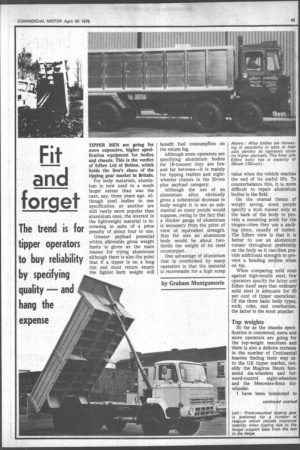Fit and forget
Page 45

Page 46

If you've noticed an error in this article please click here to report it so we can fix it.
The trend is for tipper operators to buy reliability by specifying quality — and hang the expense
by Graham Montgomerie
TIPPER MEN are going for more expensive, higher specification equipment for bodies and chassis. This is the verdict of Edbro Ltd of Bolton, which holds the lion's share of the tipping gear market in Britain.
For body materials, aluminium is now used to a much larger extent than was the case, say, three years ago. Although steel bodies to one specification or another are still vastly more popular than aluminium ones, the interest in the lightweight material is increasing in spite of a price penalty of about four to one.
Greater payload potential within allowable gross weight limits is given as the main reason for trying aluminium although there is also the point that if a tipper is on a long run and must return empty the lighter kerb weight will benefit fuel consumpfion on the return leg.
Although some operators are specifying aluminium bodies for 16-tonners they are few and far between—it is mainly for tipping trailers and eightwheeler chassis in the 20-ton plus payload category.
Although the use of an aluminium alloy obviously gives a substantial decrease in body weight it is not as substantial as many people would suppose, owing to the fact that a thicker gauge of aluminium is necessary from the point of view of equivalent strength. Size for size an aluminium body would be about twothirds the weight of its steel counterpart.
One advantage of aluminium that is overlooked by many operators is that the material is recoverable for a high scrap value when the vehicle reaches the end of its useful life. To counterbalance this, it is more difficult to repair aluminium bodies in the field.
On the eternal theme of weight saving, some people specify a stub runner only at the back of the body to provide a mounting point for the hinges—then they use a packing piece, usually of timber. The Edbro view is that it is better to use an aluminium runner throughout preferably on the body as it can then provide additional strength to prevent a bending motion when on tip.
When comparing mild steel against high-tensile steel, few operators specify the latter andi Edbro itself says that ordinary' mild steel is adequate for 99 per cent of tipper operations. Of the three basic body types, rock, coke, and overburden, the latter is the most popular.
Top weights
So far as the chassis specification is concerned, more and more operators are going for the top-weight machines and there is also a definite increase in the number of Continental heavies finding their way into the UK tipper market, notably the Magirus Deutz bonneted six-wheelers and forward-control eight-wheelers and the Mercedes-Benz sixwheeler.
I have been interested to note over the past few weeks the number of Volvo NIO chassis-cabs on their way to being bodied in spite of their high price, as this machine is a good example of the trend towards a more expensive/ higher specification tipper.
The protective canopy over the cab roof is now specified by about 50 per cent of operators.
Additional "chassis devices" such as Robson drive and bogie lift have had a rather mixed reception in this country. The Robson system where an auxiliary idler wheel comes in between the tyres of the rear axles and provides some measure of double drive on a single-drive vehicle has never really taken off for this market.
On the other hand, the bogielift concept (described in detail elsewhere in this issue) has become very popular notably on Scanias and Volvos as it provides a way of increasing traction on difficult surfaces. During the past 18 months no fewer than 40 per cent of the six-wheeler F86 Volvos have been ordered with bogie lift, but even this figure is overshadowed by the massive 80 per cent which is the figure quoted by Scania for bogie-lift specification on chassis ordered since January 1975.
Longer bodies
With the actual tipping gear, the trend is towards the frontmounted single-ram type compared with, say, 15 years ago when all operators specified twin rams. The seal areas are approximately the same, but the use of smaller diameter rams means they take up less space and consequently allow a slightly longer body to be fitted. The twin-ram gear can rock a little in practice, which gives the flexibility that many operators like.
The underbody gear is mainly used if there is no room at the front of the body. However, underbody gear has a greater tendency to bend the frame when in operation so additional flitching is usually required. Some operators want underbody gear as they claim that the rams are less likely to be bent by drivers tipping on uneven ground. If a vehicle is limited in body length it is still possible to avoid using underbody gear by recessing a front-mounted ram into the bodywork.
Front-mounted tipping gear improves the stability of the truck by virtue of its longer support base from the ram to the body hinge.
Whereas a number of years ago the tipping trailer was extremely popular, the increase in allowable gvw from 28 to 30 tons has allowed the eightwheeler to catch up on payload capacity. With six-wheelers still being restricted to an onroad gvw of 24 tons, most operators are plumping for the eight-wheeler to give a proportionally greater payload.
Power-take-off, controls are being requested in the main with air shifts rather than cables or rods. The air system has two major advantages in that the nylon pipes usually used require smaller holes in the bodywork and the pipe flexibility makes the system ideal for tilt cabs.
In general it would appear that the tipper men are looking for higher quality machinery which will allow them to "fit and forget".
















































































































































